
Mu Cang Chai
How to travel to Mu Cang Chai for your best experience
Mu Cang Chai Travel Guide – What to do, when to visit, and more…
Being an upland district of Yen Bai province, about 2,000 meters high above sea level and 300 km away from Hanoi, Mu Cang Chai is home to one of the most magnificent cultivated topography in Northern Vietnam.
Mu Cang Chai is home to some of Asia’s most magnificent cultivated topography. Rice terraces coil in ribbons around the hills to spectacular effect, luring photographers, hikers, and avid motorbikers. Ready for an adventure? Whatever you’re looking for, here are four things you’ll simply love about Mu Cang Chai.
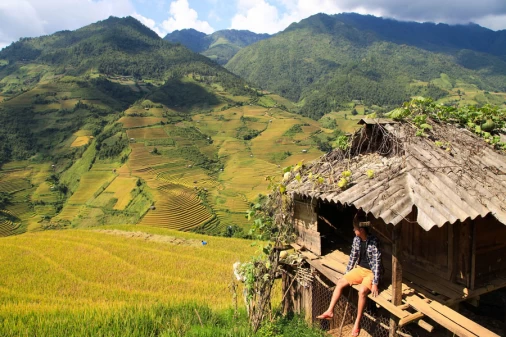
Che Cu Nha Village
Che Cu Nha Village is located in Mu Cang Chai, Yen Bai province, the Che Cu Nha village is one of...
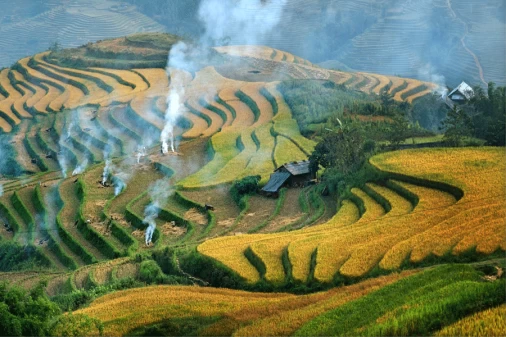
De Xu Phinh village
De Xu Phinh or (Ze Xu Phinh) is located in Mu Cang Chai, Yen Bai province, the is one of the three...
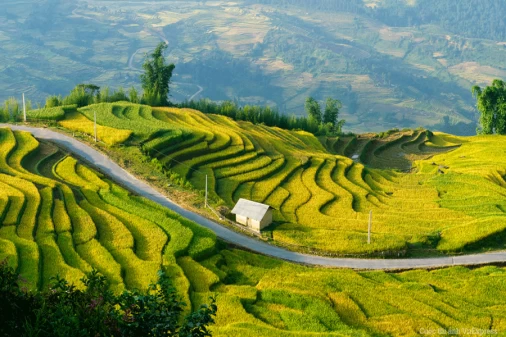
Khau Pha Pass
From Yen Bai City, vice along Highway 32 about 5 hours, through communal Tu Le, Khau Pha Pass, Mu Cang...
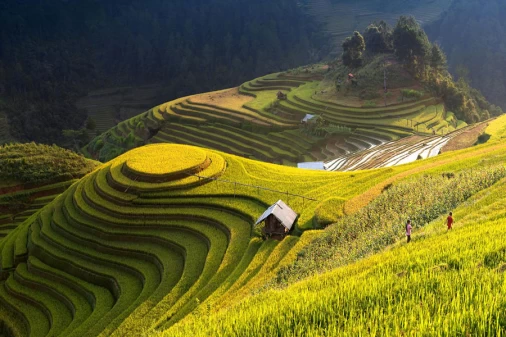
La Pan Tan village
La Pan Tan village (bản La Pán Tẩn) is the region has most beautiful terraces in Mu Cang Chai district...
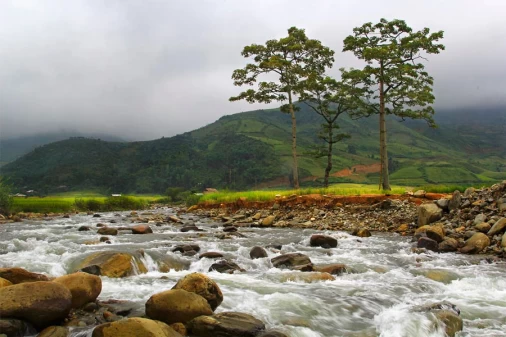
Lim Mong Village
Lim Mong in Cao Pha village, Mu Cang Chai district – Lin Mong is one of must visit in Mu Cang Chai –...
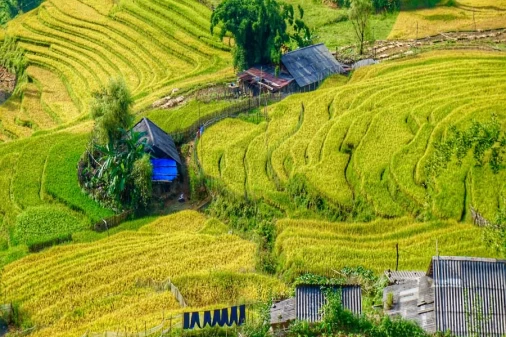
Lim Thai Village
Not only famous for the beautiful places, Yen Bai also do tourists by the beauty of the countryside,...
Frequently asked questions
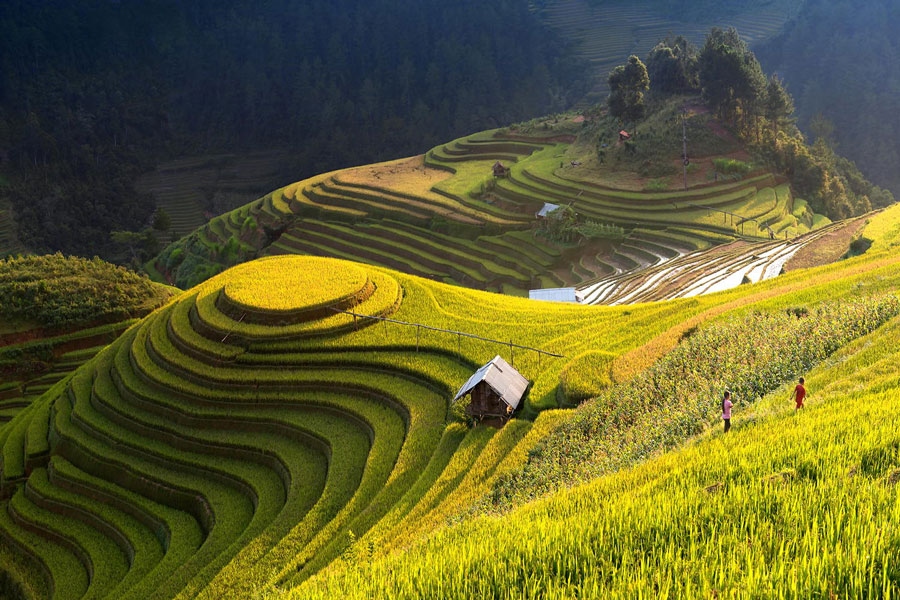
Being an upland district of Yen Bai province, about 2,000 meters high above sea level and 300 km away from Hanoi, Mu Cang Chai is home to one of the most magnificent cultivated topography in Northern Vietnam.
The special about Mu Cang Chai is rice terraces coiling in ribbons around the hills to spectacular effect, luring photographers, hikers, and adventurous travelers. The scene is so amazing that Mu Cang Chai was listed among the ‘Top 50 most beautiful places in the world’ by CNTraveler. Paying a visit to this charming land might be one of the wisest choices of tourists in Vietnam.
I. To visit the top attractions
1. Khau Pha Pass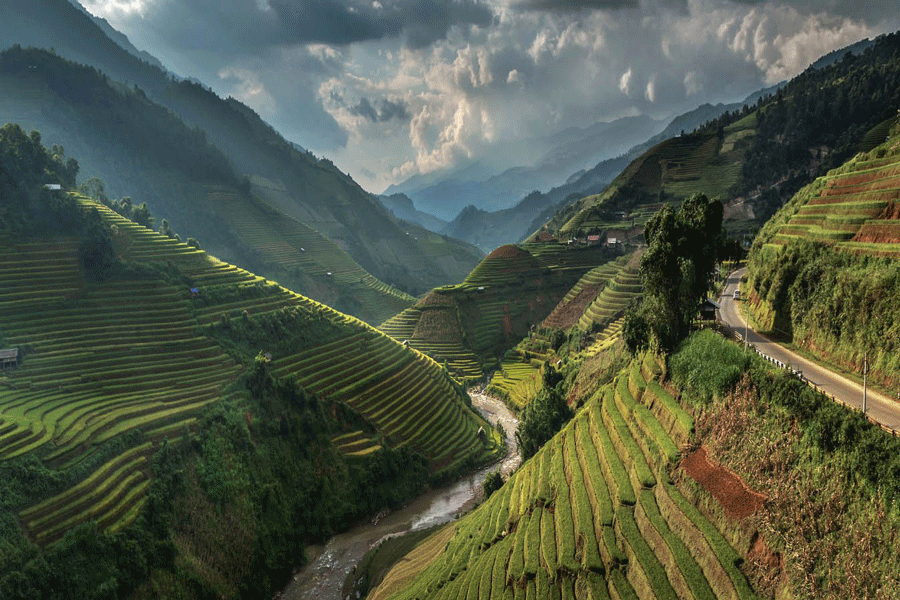
Literally called “The Sky’s Horn”, the Khau Pha is one of the longest mountain passes in Vietnam, at an elevation of 1,500 meters above sea level. Traveling from Yen Bai city through Tu Le commune, Khau Pha pass appears between plateaus surrounded by mountain ranges. The winding passage between the old jungle still having the bold features and the terraced fields of the Hmong, Thai. Riding on this pass, you’ll have the chance to see the magnificent sceneries of nature. Like the name of the pass describes, you might see the top of the pass laden with dense fog – looking like a horn rising through the sea of clouds.
2. Lung Lo Pass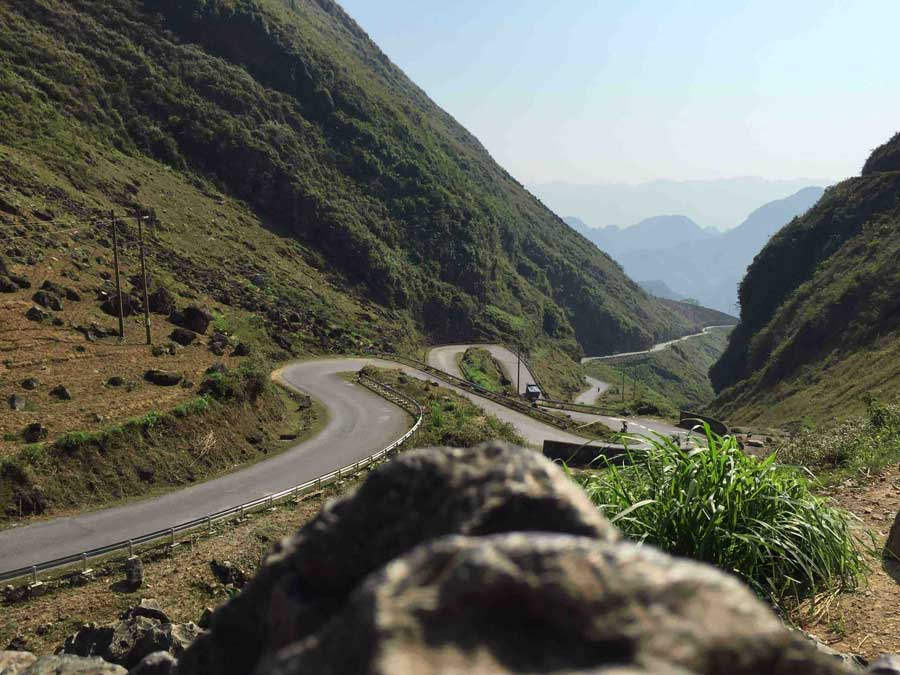
Located between the provinces of Yen Bai and Son La, Lung Lo Pass is a spot with many legends and glorious history about the wartime. For those who love adventure, conquering the Lung Lo Pass is much interesting as traveling along the journey, you will have the opportunity to enjoy the specialties of the locals and admire the wild beauty from the peak of the pass, with the grandeur of mountains, green valleys, terraced fields, and cornfields. Come here and challenge yourself (with safety comes first, of course), you would never regret the effort.
3. Tu Le Commune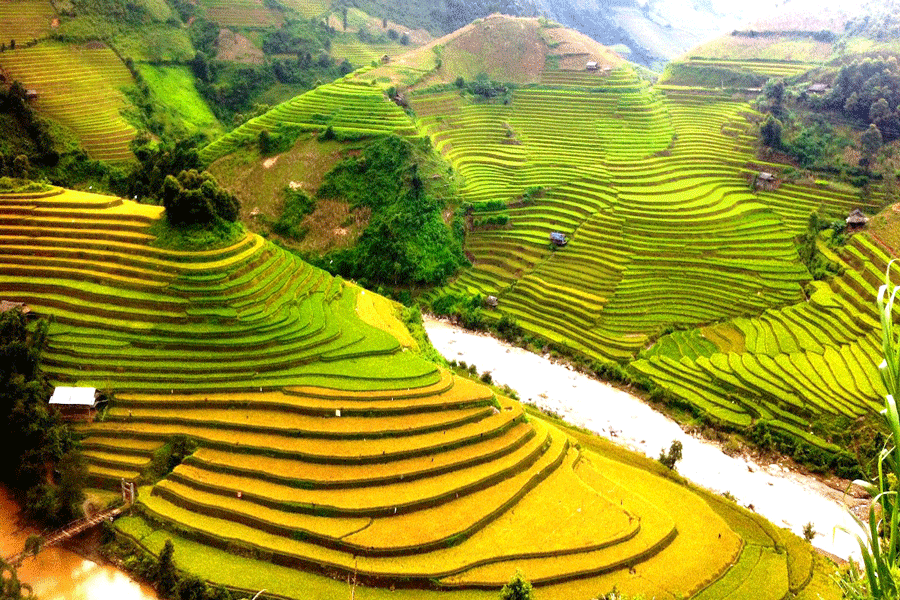
Located at Van Chan District, Tu Le is one of the favorite destinations for many visitors who have a great love for nature. Traveling across 35 kilometers from Mu Cang Chai following the Highway 32, you know that you have arrived when a vast valley of rice fields, crisscrossed by the freshwater streams come into your sight, with the smell of new rice flies in the wind on the roof. If you look closely, here and there on the valley are the idyllic stilt houses’ grey roofs of Thai villages.
While visiting Tu Le commune, visitors often come to check out the hot spring in Chao Village which is about one kilometer from the town. At this hot spring, you can witness a beautiful tradition (but sensitive) practice of Thai women – naked bathing after a hard-working day. However, maintain a distance while approaching so you would not make the locals uncomfortable.
4. Che Cu Nha Village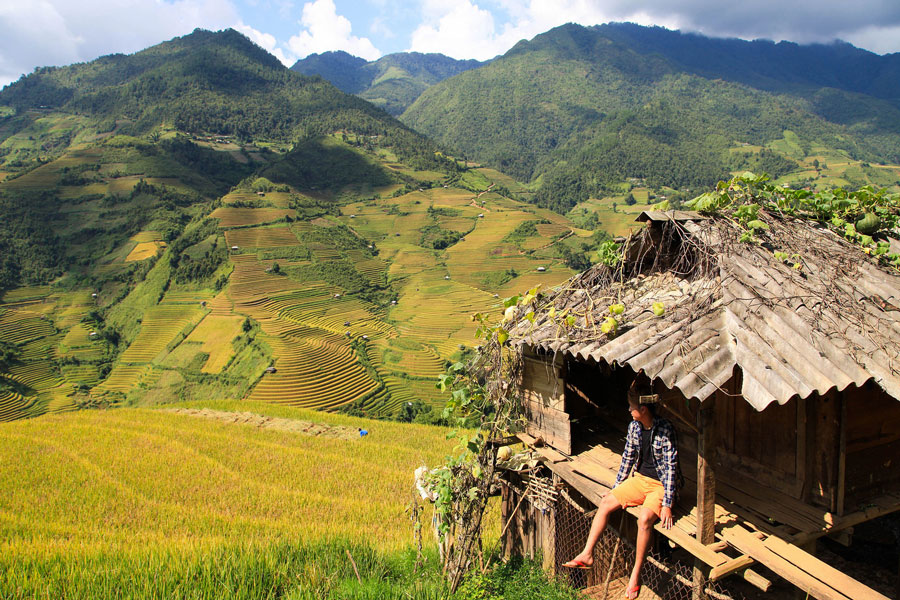
Che Cu Nha is a remote commune and one of the three places with the most beautiful terraced fields in Mu Cang Chai. Locals here are almost H’Mong ethnic people with rich culture and practices. At Che Cu Nha, prepare for the very steep uphill slopes and full views of the terraced rice fields.
The road up to terraced rice fields’ viewpoint is only 2 kilometers but very steep. When you get to the top, the views are absolutely rewarding, especially on sunny days. From the viewpoint, you can take in the panoramic scene of the surrounding mountains whose whole bodies are cultivated into terraced rice fields.
5. La Pan Tan Village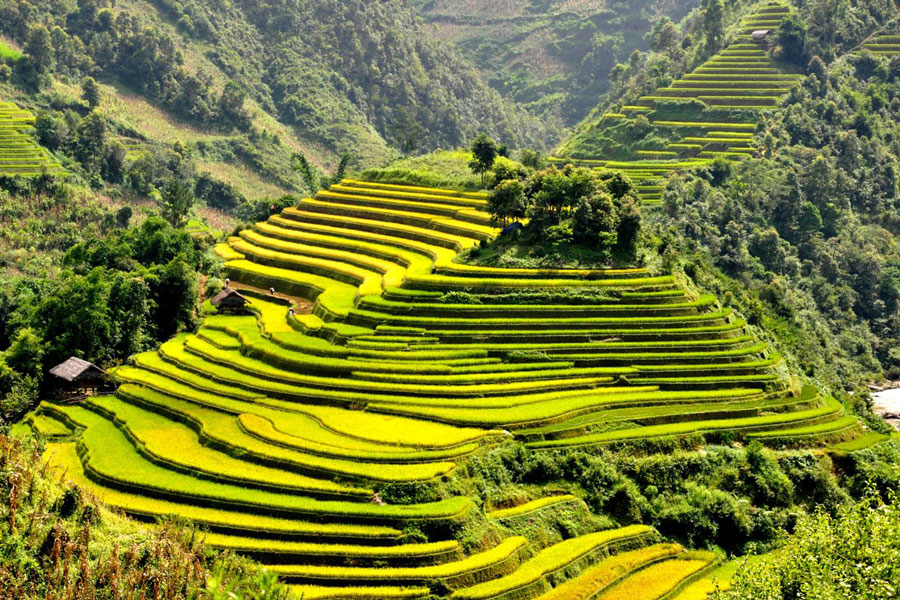
La Pan Tan village is indeed the region that has the most beautiful terraces in Mu Cang Chai, as the whole hill is made into terraces, and the top of the hill is a round shape like a tray of sticky rice.
On sunny days, the golden field will turn even more vivid, making it a wonderful site for photography. For this reason, the rice terrace fields in La Pan Tan village have been recognized as national landscapes by the Ministry of Culture–Sports & Tourism. It can be said that your Mu Cang Chai trip is incomplete without visiting this site.
6. Lim Mong Village
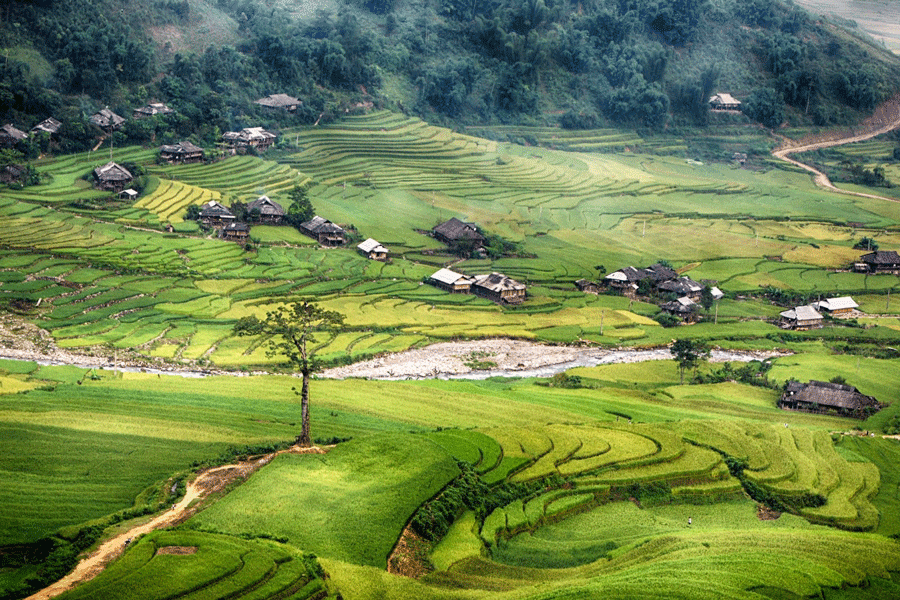
Located on the side of Khau Pha pass, Lin Mong has a wonderful view of the terrace with dusty red dirt road where live cattle, live horses appear intertwined challenging, but the scenery along the way to an incredibly interesting. You’ll stupor before the incomparable beauty of the terraced rice fields – the fruits of her labor fantastic Mong people for a year.
New rice sweet flavor as dry dispel the harsh sun. Long rice fields, laden with beads, green. Season rice transplanting is carried on the sleeve of a rich and prosperous. And the lower stream is a great place to have a small picnic while admiring the nature around you.
7. Mo & Pu Nhu Waterfall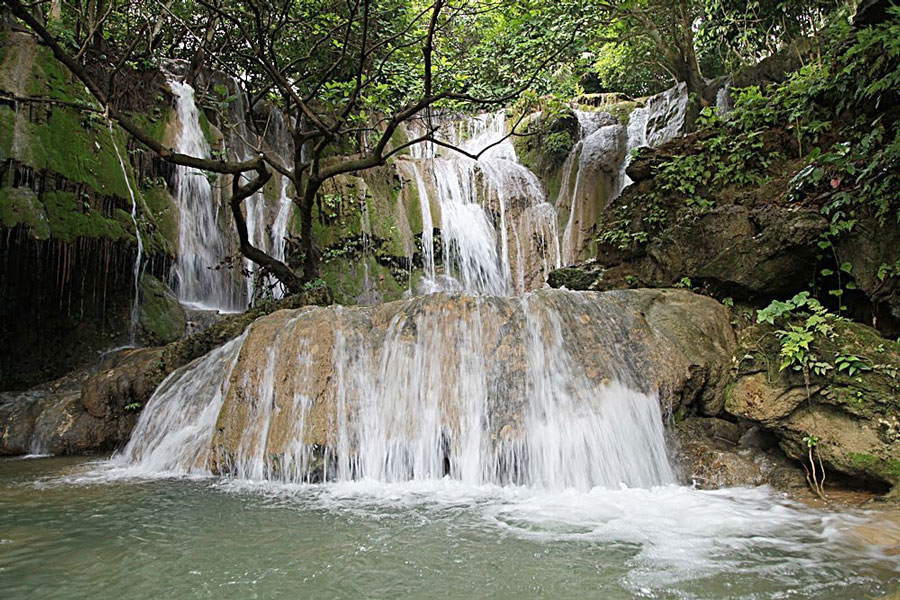
Mo (Dream) is a famous waterfall in Mu Cang Chai, like a white silk silver sparkling softly stretch of about 3,000 meters between peaks Na Hang A and Na Hang B. The waterfall is most beautiful in the rainy season with its full volume of water dropping down on the height of about 40 meters. On the top level, you will have a chance to take in the wonderful views of nature. This is a beautiful waterfall in Mu Cang Chai – one must-see for a tourist.
Pu Nhu Waterfall originated from the streams in the watershed forests from Than Uyen (Lao Cai), the waterfall is about 20 meters high with an impressive rock setting, divided into many steps. The fall confluence of many streams and watersheds from Than Uyen, Lai Chai. This waterfall is a great place to enjoy picnicking.
II. To be free on your own activities
1. Go hiking
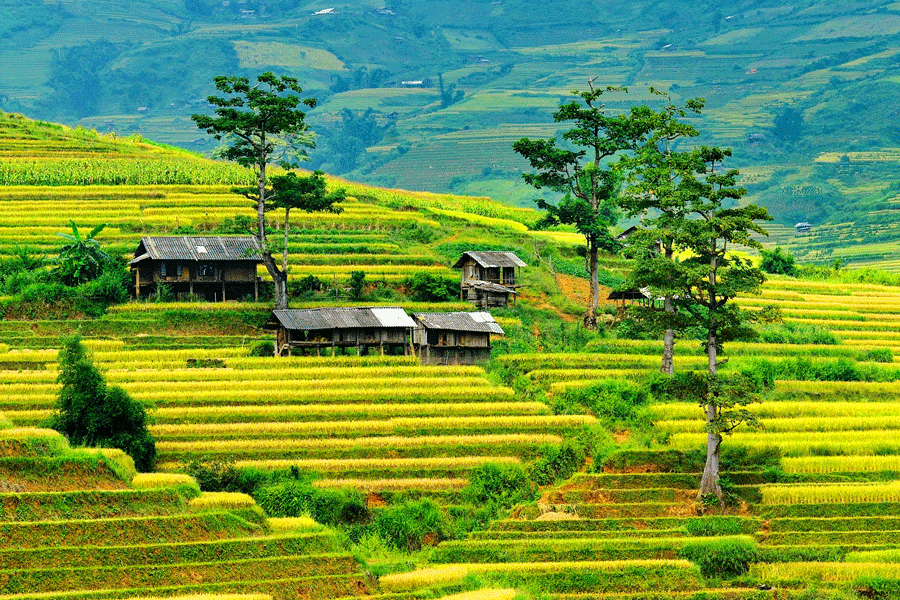
Hiking is a great way to absorb Mu Cang Chai’s scenery at a slower pace. You’ll pass layers of rice terraces, tea, and corn plantations, and higher up, primary tropical rainforest. Hiking may be a new activity in Mu Cang Chai, but the H’ mong has been roaming these hills for centuries.
Until recently, villagers traveled almost everywhere on foot, creating a network of trails that zigzag up the valleys and into the mountains. These trails connect every hamlet and provide excellent hiking routes for long and short forays.
2. Go biking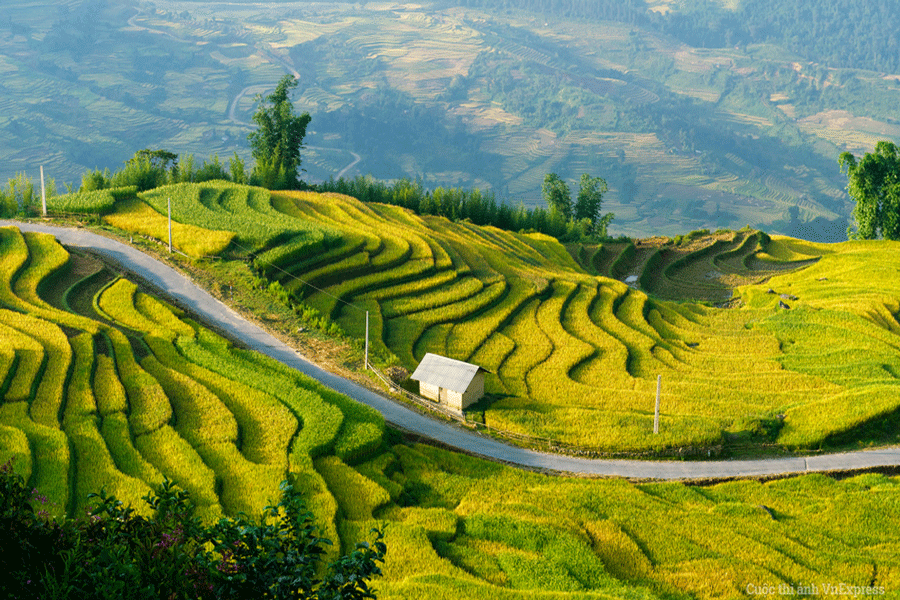
Mu Cang Chai is one of the best places in Vietnam to take on the roads. You’ll find quality strips of tarmac that weave around oval hills and sky-high dirt tracks that cling to near-vertical cliff faces. Whether you want a gentle ride following trickling rivers or an adrenaline-filled dirt bike experience, Mu Cang Chai provides the stage.
Notable main roads include the magnificent stretch between Mu Cang Chai town and Tu Le via the Khau Pha mountain pass. For a gentle ride through ethnic Thai villages, continue to Nghia Lo before circling back. Off the main road, a ride up to Mo-De village offers more great views on a mostly paved road.
3. Try a homestay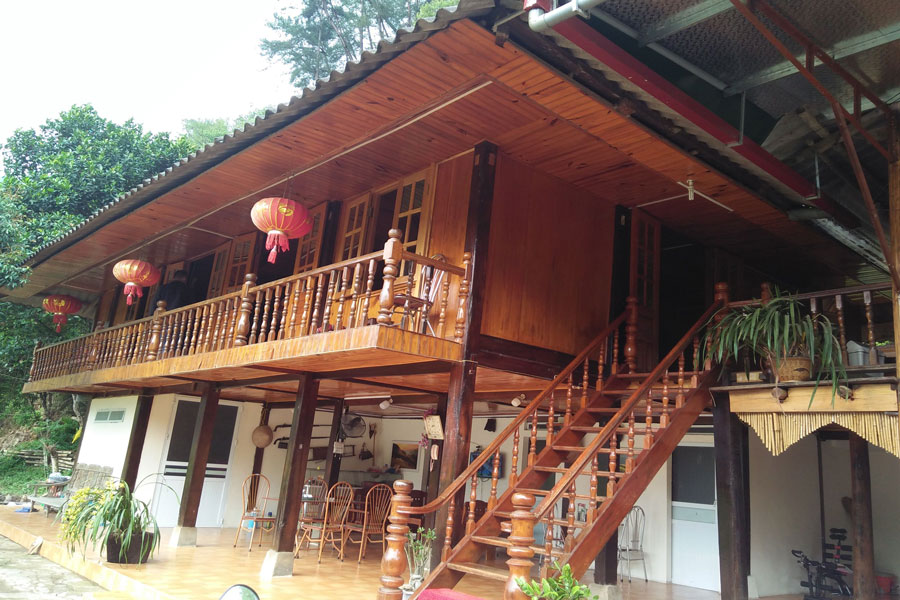
Although there is a number of qualified hotels and resorts around, but spending a night in a clean traditional house-on-stilts of a local family might be one of your best experience in Mu Cang Chai. You will be treated as a family member with delicious dishes, local alcoholic drinks and cook with them.
However, there’s no private room and you’ll sleep on the floor in a large communal area, of which the sleeping corner is set up with a single mattress (thin, but adequate), blankets (ditto), pillow and mosquito net. But it was never translated into a complaint by tourists by far.
For first-timers, you may want to check out our suggested a 3-day & 2-night itinerary discovering Mu Cang Chai and enjoy it your way.
Day 1: Mu Cang Chai arrival – Khau Pha Pass – Tu Le Commune – Chao Village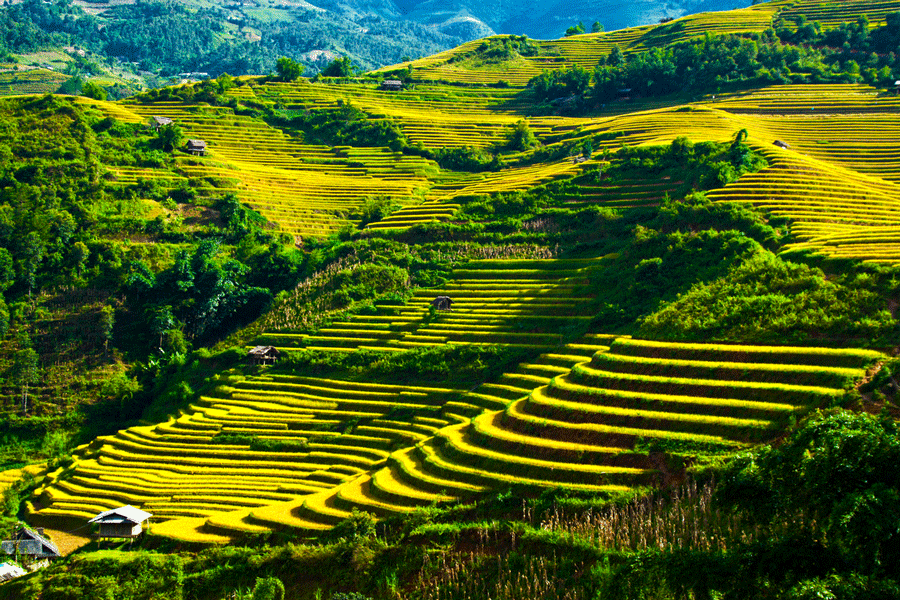
AM: Starting from Hanoi heading toward Mu Cang Chai. Enjoy breathtaking scenes of Khai Pass en route. Reach Tu Le commune and have lunch.
PM: Trek across and enjoy sightseeing around Tu Le. Stop at Chao village to visit the hot spring, meet Thai people, dine with locals and have a homestay.
Day 2: Che Cu Nha Village – La Pan Tan Village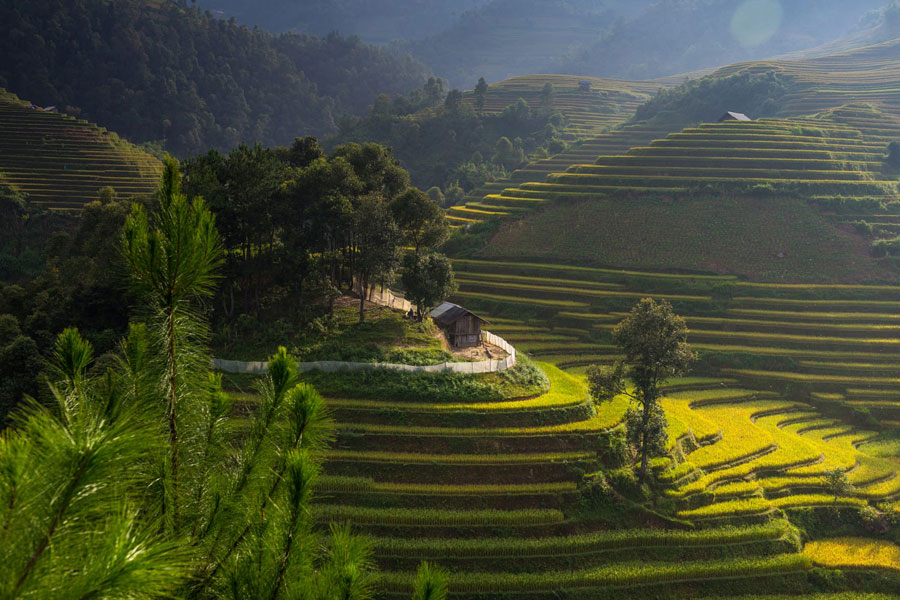
AM: Trek across a 10km dirt road to Che Cu Nha village. Make friends with the H’mong and try a day to be a farmer on the terrace fields.
PM: Continue walking to La Pan Tan village and witness the most beautiful paddy fields of Mu Cang Chai. Visit a local’s home, join a dinner and experience another pleasant homestay.
If you are a veteran backpacker, please feel free to manage the trip your own and alter it when needed, else, we recommend you join a tour organized by a professional company, that can free you from hassles and keep you safe throughout the journey.
1. Five-colored sticky rice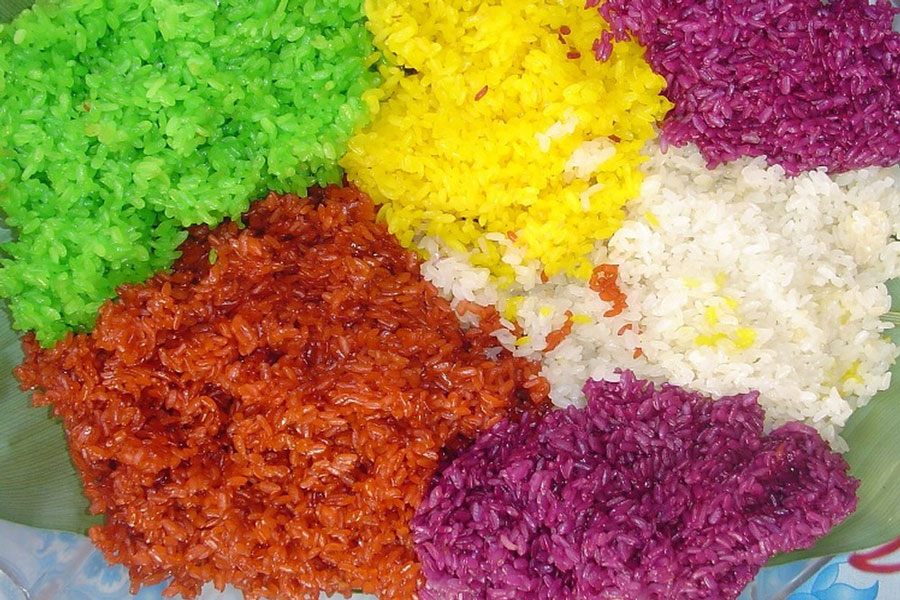
The sticky rice is made from glutinous rice but the colors are made from natural ingredients. There will be five different colors including green, yellow, red, purple and white.
Due to different ingredients, the fragrances of each colored sticky rice will be different, too. You can find this dish most frequently at fair markets.
2. Com (Green rice)
Com made in Tu Le Commune is well-known to visitors across the country. The rice grains in Tu Le are big, white and almost transparent, making the green rice has a sweet taste and light fragrance. The dish requires a meticulous process of making which the locals are so dedicated and careful in each step. During the harvest season, you can find green rice sold by the locals on the roadside or in local markets and restaurants.
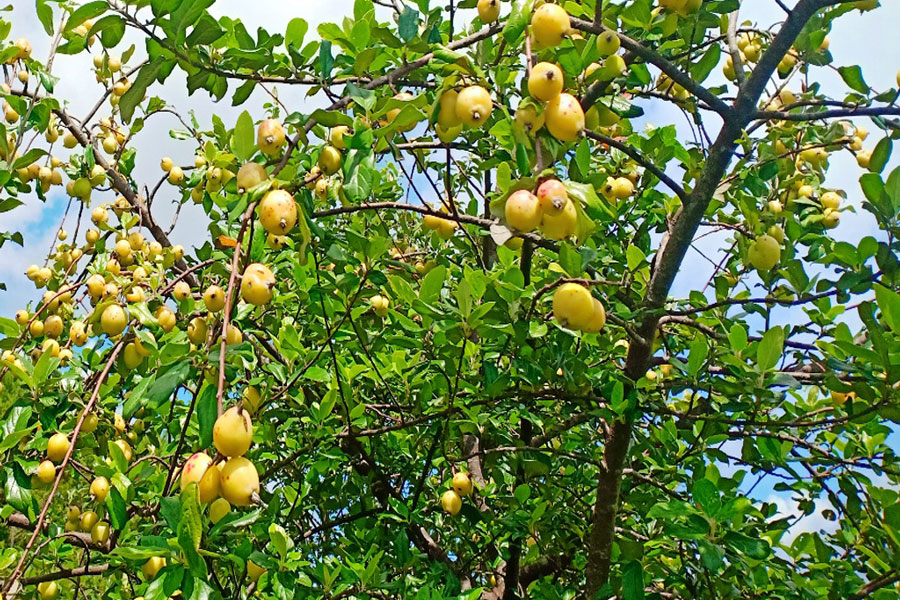
3. Tao Meo (Meo apple)
Meo apple is the common fruit in northwest Vietnam and quite well-known across the country for its health beneficial characteristics (like treating stomach pains, high blood pressure, and even heat-related illnesses).
Meo apple is small, planted mostly in the mountainous regions and can be found in Mu Cang Chai between September and October. The apple tastes sour and lightly bitter which makes Tao Meo very special fruit to try in Mu Cang Chai.
Mu Cang Chai weather overview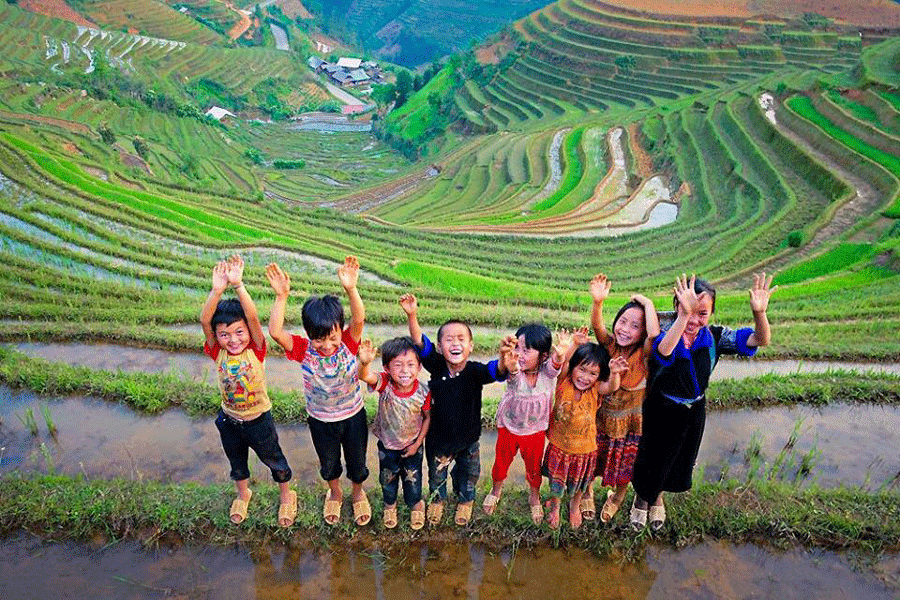
At the high location of Hoang Lien Mountain, which is nearly 2,000 meters above sea level, Mu Cang Chai has an average temperature of 23 degrees Celsius and the typical tropical monsoon climate. Its weather divides into two main seasons: the Dry & Rainy ones with cool summer & cold winter.
With its 6 cold winter months (November to April), the region is so cold & dry to plant the rice, that is why there is one crop of rice in Mu Cang Chai in the summer season (May to October) when the rice terraces are watered by summer rains. But naturally, each season has its own characteristic charm in specific months.
1. The falling season in early June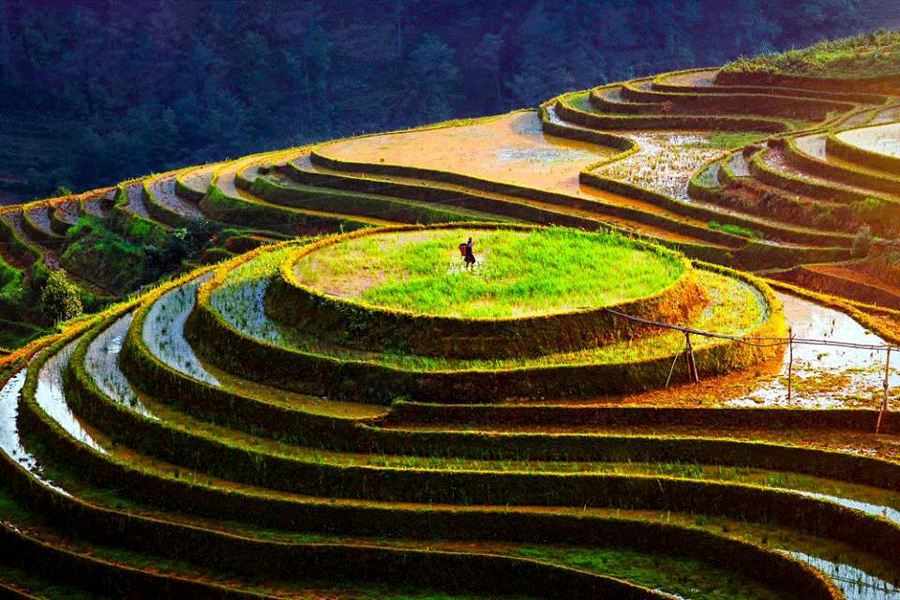
There is only one crop per year in Mu Cang Chai and it takes place from June to October. In June, when the first summer shower coming to the North of Vietnam, hill tribe people in Mu Cang Chai all come to their field for preparing the new crop of rice.
As all the field in Mu Cang Chai are terrace rice field so they all need to supply water from the top terrace of the field, and water from there just keep coming from top to the bottom of the rice field, and local people call this “falling water reason”.
In this season, you will see allots of activities of people working on the field, from a plow to harrow on the field with water buffalo, replanting rice. Normally they work in groups with very beautiful and colorful clothes of hill tribe women, and it can be very interesting for very good photo shooting on the field in this period.
2. The middle of the crop in July to September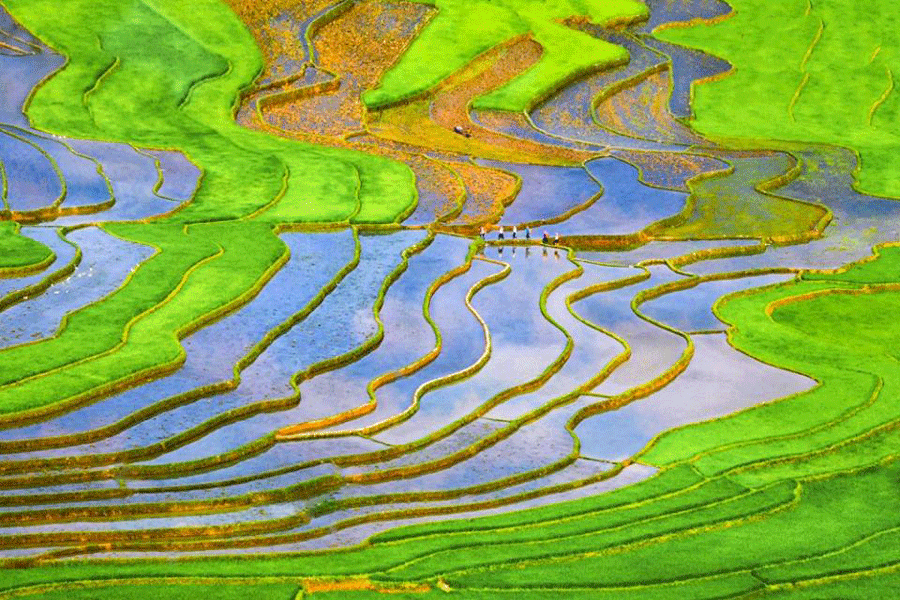
The middle of the crop will be from late June/ early July to the middle of September. During this time, the whole tremendous terrace rice field in Mu Cang Chai will be covered by the lovely and peaceful carpet of rice.
The color of green on the field even can cool you down in the hot summer sun. You will not see many local people activities on the field this season, but the greenness of the rice field can be very good compensation.
3. The harvest time in September/ October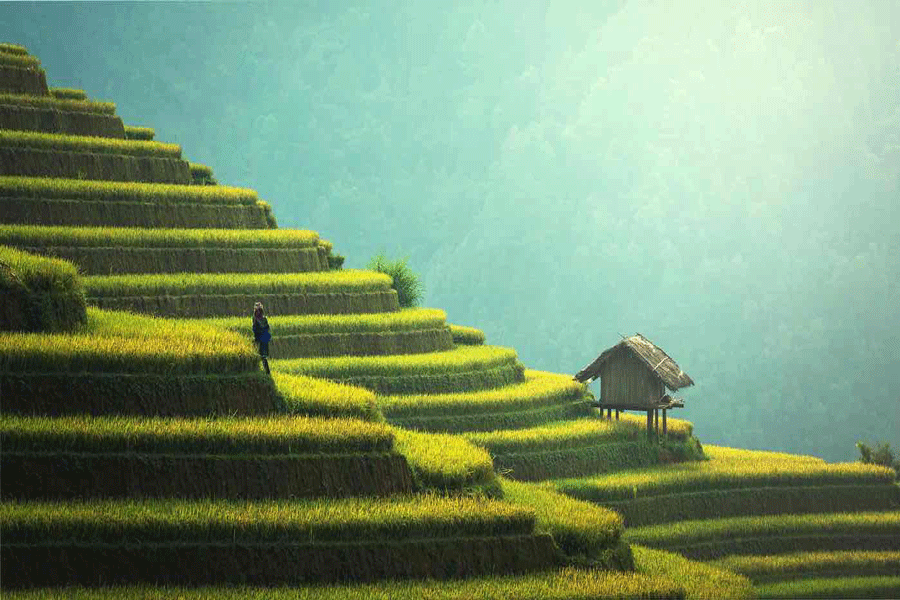
In the harvest time for the rice crop, travelers take the visit to Mu Cang Chai from late September to early October to see and take photographs of waves of terraced rice fields, as this is when the fields turn brilliant yellow and shine in their fullest beauty. This is also the time when the fields become full of life as H’mong ethnic minority farmers in their traditional attire harvest the ripe rice grains, and shoulder bags of the fruit home through mountains and hills as well as over swinging suspension bridges.
It is in late harvest season that visitors can distinguish the atmosphere of terraced fields in the rice harvest season and offseason. The real charm of yellow fields and the fields without paddy, and above all the type of soil and the attempts of the farmers to produce paddy, are most obvious at this time. Great time to collect beautiful pictures!
Mu Cang Chai by seasons review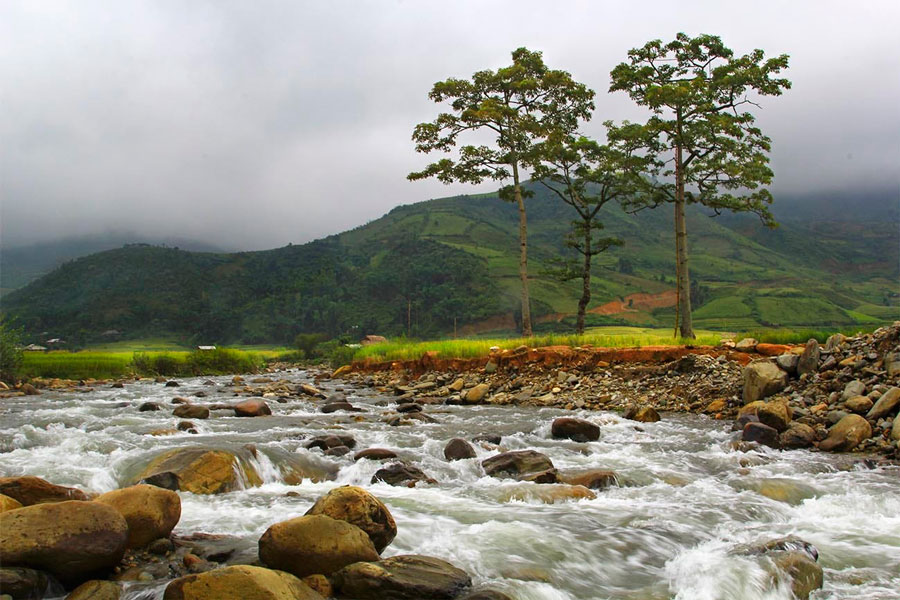
During the summer, the terraces bulge with ripening rice stems that blanket the hills in a vibrant green. By early autumn, the rice plants have turned a bewitching golden yellow, ready for the harvest.
In wintertime, the lonely terraces fill with water, creating cascading rows of reflective infinity pools. Once spring comes, the terraces transform into anthills of activity, as the farmers plant a new crop.
Mu Cang Chai is 300km far from Hanoi following the main hilly & winding national road 32 so it will take you at least 7 hours to reach from Hanoi. Transportation means available are trains, buses, and motorbikes.
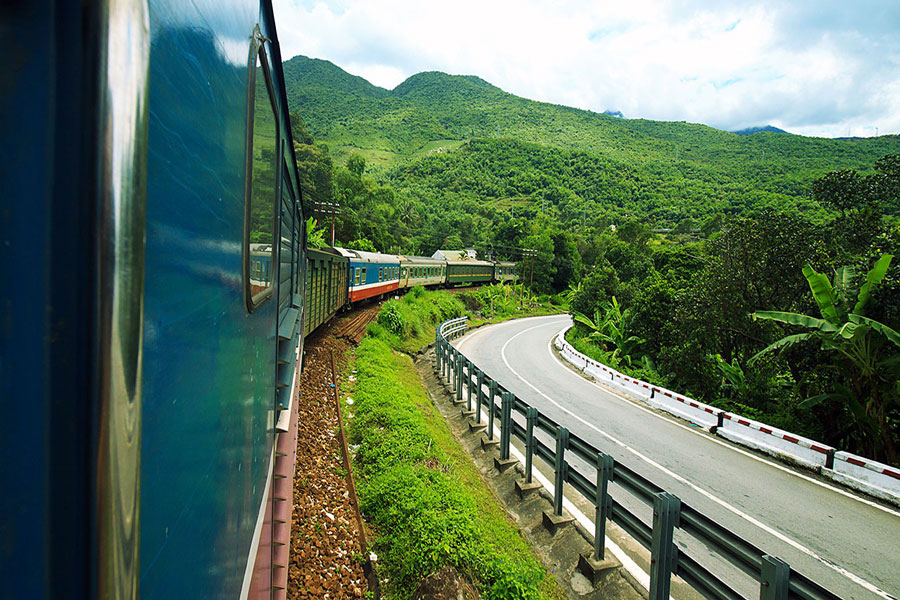
By Train: The Hanoi – Lao Cai train will stop and drop you off at Yen Bai railway station, from there you will have to catch a bus to Mu Cang Chai for a cost of about 100,000VND.
By Bus: Buses to Yen Bai or Nghia Lo are available at My Dinh and Giap Bat bus stations. At Yen Bai or Nghia Lo, take a local bus to Nghia Lo and Mu Cang Chai or Mu Cang Chai.
By motorbike: It will take you about 8 hours of riding. Therefore, you shouldn’t ride continuously. Take rest at Nghia Lo town for the first night and conquer the rest on the second day.
Throughout this article, we wish you to have an idea of how to travel to Mu Cang Chai for your best experience. In case you are looking for your own travel agent, who can offer a wonderful and hassle-free trip to Mu Cang Chai, please feel free to let us know. We always commit our best to make it your once-in-a-lifetime journey.
You may also like
Vietnam Northwest discovery 9 Days
- Depart Time:Daily
- Starts/Ends:Hanoi/Hanoi
- Tour type:Private Tours
- Travel Style:Nature & Adventure, Heritage Tours, Culture & History
- Activities:Cruise tours, Walking tours, Local culture tours, Cultural, religious and historic sites tours, Countryside and village visits tours
- Suitable for:Solo, Family, Group, Couple
- Age range:1 To 90 Years
- Operated in:English, French, Spanish, German, Italian
Mu Cang Chai – Sapa – Halong 9 Days
- Depart Time:Daily
- Starts/Ends:Hanoi/Hanoi
- Tour type:Private Tours
- Travel Style:Nature & Adventure, Heritage Tours, Family Tours, Culture & History
- Activities:Trekking and Hiking, Cruise tours, Local culture tours, Cultural, religious and historic sites tours, Countryside and village visits tours
- Suitable for:Solo, Family, Group, Couple
- Age range:1 To 90 Years
- Operated in:English, French, Spanish, German, Italian
Halong Bay & Mu Cang Chai 7 days
- Depart Time:Daily
- Starts/Ends:Hanoi/Hanoi
- Tour type:Private Tours
- Travel Style:Nature & Adventure, Heritage Tours
- Activities:Cruise tours, Sightseeing Tours, Local culture tours, Countryside and village visits tours
- Suitable for:Solo, Family, Group, Couple
- Age range:1 To 90 Years
- Operated in:English, French, Spanish, German, Italian
Best Mu Cang Chai Tours 4 Days
- Depart Time:Daily
- Starts/Ends:Hanoi/Hanoi
- Tour type:Private Tours
- Travel Style:Nature & Adventure
- Activities:Trekking and Hiking, Sightseeing Tours, Local culture tours, Countryside and village visits tours
- Suitable for:Solo, Family, Group, Couple
- Age range:1 To 90 Years
- Operated in:English, French, Spanish, German, Italian
Explorer Mu Cang Chai 3 Days
- Depart Time:Daily
- Starts/Ends:Hanoi/Hanoi
- Tour type:Private Tours
- Travel Style:Nature & Adventure
- Activities:Walking tours, Local culture tours, Countryside and village visits tours
- Suitable for:Solo, Family, Group, Couple
- Age range:1 To 90 Years
- Operated in:English, French, Spanish, German, Italian
 France
France  Spain
Spain  German
German  Italian
Italian 






 Vietnam Tours
Vietnam Tours  Cambodia Tours
Cambodia Tours  Myanmar tours
Myanmar tours  Thailand Tours
Thailand Tours  Laos Tours
Laos Tours